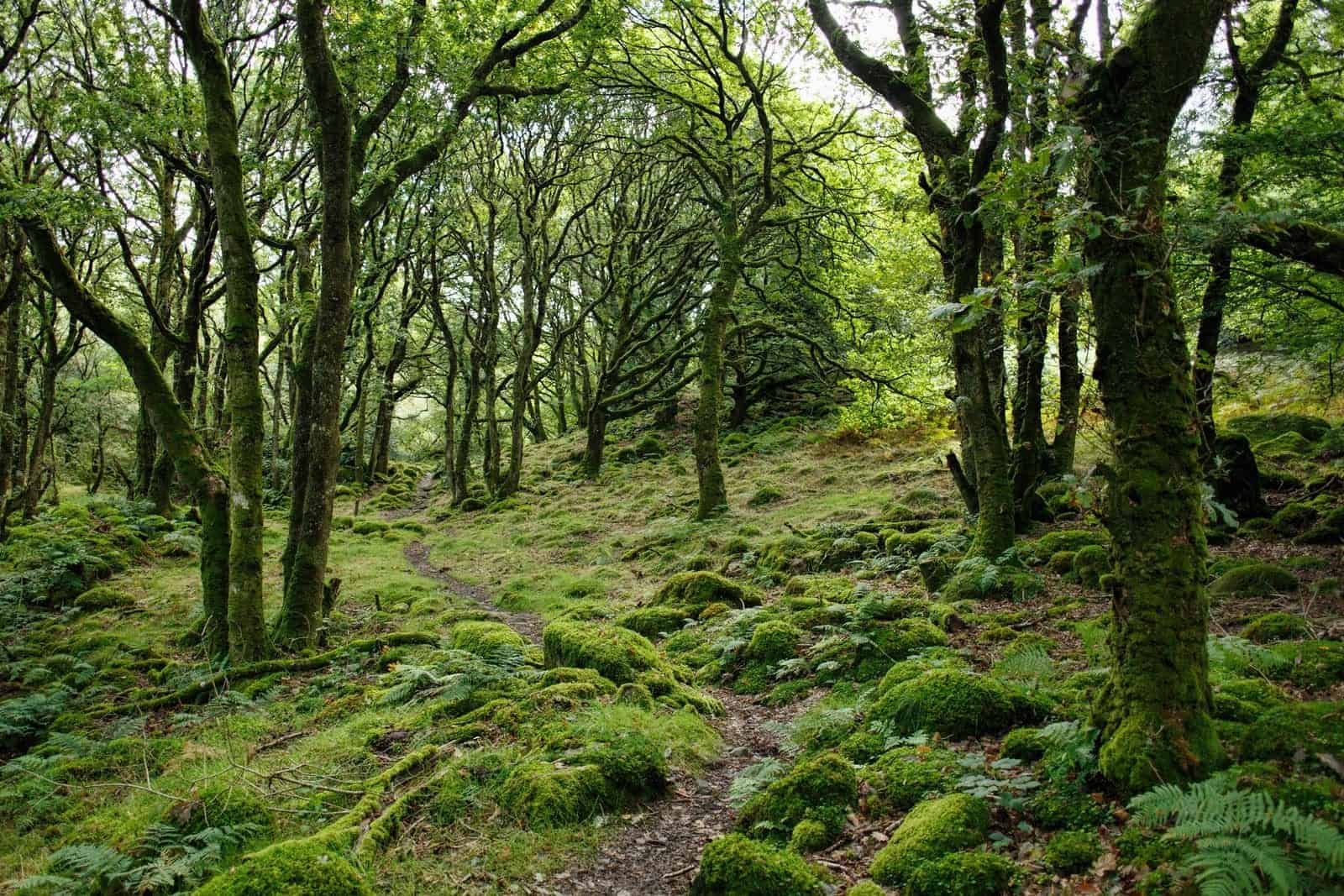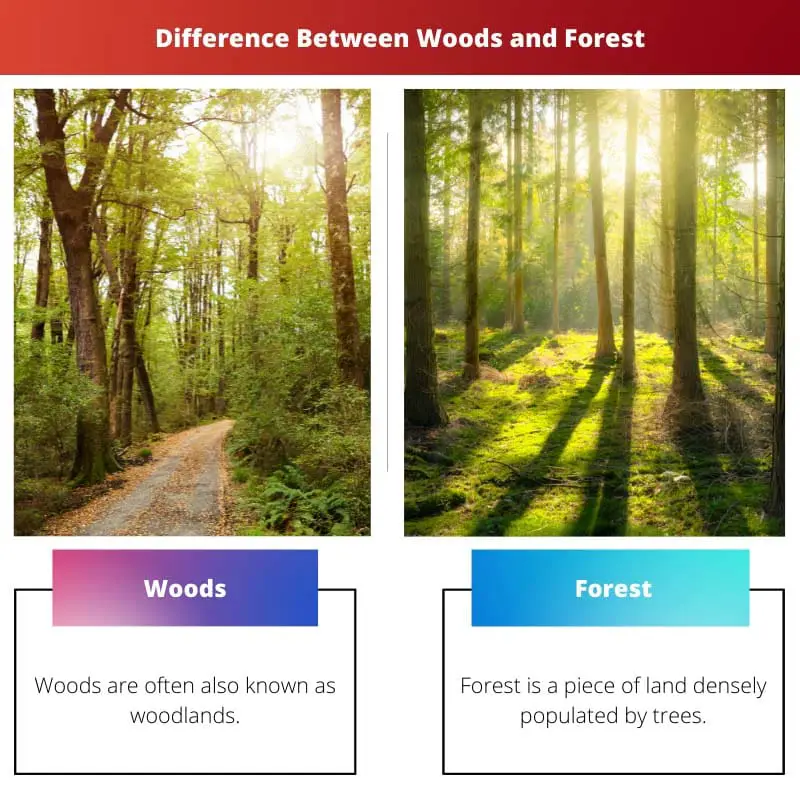“Woods” refers to a smaller area covered with trees, managed or cultivated, while “forest” denotes a larger expanse of densely wooded land, natural and wild.
Key Takeaways
- Woods are smaller areas of trees and vegetation, while forests are larger and more densely populated with trees.
- Woods are used for recreation, hunting, and gathering, while forests are managed for commercial purposes like logging and paper production.
- Woods are easier to navigate and have a lighter environmental impact than forests, which can be more difficult to manage sustainably.
Woods vs. Forest
Woods are smaller than forests and are characterized by smaller and younger trees, found near residential areas. They are used for recreational purposes such as hiking or hunting. Forests are important habitats for plants and animals, providing ecosystem services such as carbon sequestration and soil stabilization.

Woods are also known as woodlands. They are pieces of land entirely covered with trees. They are smaller than trees and have a lesser tree population than forests.
Woods allows the growth of shrubs and herbaceous plants like grasses.
Forests are land that is densely populated with trees. Forests are the dominant terrestrial ecosystem of the earth. They are high in the population of trees, and the percentage of land covered by the canopy is larger.
Human society and forests are impacted by each other’s presence positively and negatively.
Comparison Table
| Feature | Woods | Forest |
|---|---|---|
| Tree Canopy Cover | 25% – 60% | 60% – 100% |
| Tree Height | At least 5 meters (16 feet) | At least 5 meters (16 feet) |
| Size | Generally smaller, less than 1.24 acres (0.5 hectares) | Larger, can be much larger than 1.24 acres (0.5 hectares) |
| Density | More open, with sunlight reaching the ground | Denser, with more limited sunlight reaching the ground |
| Biodiversity | Can support diverse plant and animal life, but potentially less variety than a forest | Supports a wider variety of plant and animal life due to the complex ecosystem |
| Terminology | Often used interchangeably in everyday language | The stricter scientific term for a larger, denser area of trees |
What are Woods?
Woods are defined as areas covered with trees, smaller in size compared to forests. They have a mixture of tree species and may be interspersed with clearings or trails. Woods are commonly found in suburban or rural areas and can be either natural or semi-natural.
Characteristics of Woods
- Size and Scale:
- Woods are smaller in scale compared to forests, covering relatively limited areas.
- They can range from a few acres to several hundred acres in size, depending on the local environment and human activities.
- Tree Composition:
- Woods consist of a diverse mix of tree species, including both deciduous and evergreen varieties.
- Due to their smaller size, woods may exhibit more variability in tree composition compared to larger, more homogeneous forests.
- Human Interaction:
- Woods bear signs of human interaction, such as trails, paths, or clearings, indicating some level of management or use by humans.
- They may be subject to selective logging, recreational activities like hiking or camping, or other forms of human intervention.
- Ecological Importance:
- Despite their smaller size, woods play a crucial role in local ecosystems, providing habitats for various plant and animal species.
- They contribute to biodiversity conservation, carbon sequestration, and soil protection, albeit on a smaller scale compared to forests.
- Cultural Significance:
- Woods have cultural significance in many societies, serving as settings for folklore, recreational activities, or artistic inspiration.
- They evoke a sense of tranquility and intimacy with nature, offering spaces for reflection, relaxation, and exploration.

What is Forest?
Forests are expansive ecosystems dominated by trees and encompassing a variety of plant, animal, and fungal species. They are essential components of terrestrial ecosystems, playing critical roles in biodiversity conservation, climate regulation, and the provision of ecosystem services.
Characteristics of Forests
- Size and Scale:
- Forests cover vast expanses of land, ranging from thousands to millions of hectares.
- They can be found across diverse climatic zones, from tropical rainforests near the equator to boreal forests in colder regions.
- Tree Dominance:
- Forests are characterized by the dominance of trees, which form a dense canopy layer covering the majority of the landscape.
- These trees vary in species composition, height, and density, contributing to the structural complexity of forest ecosystems.
- Biodiversity Hotspots:
- Forests harbor a wealth of biodiversity, supporting numerous plant, animal, and microbial species.
- They provide habitat for diverse flora and fauna, including endangered and endemic species, making forests crucial biodiversity hotspots.
- Ecosystem Services:
- Forests offer a wide range of ecosystem services, including carbon sequestration, oxygen production, water regulation, and soil stabilization.
- They contribute to climate regulation by absorbing carbon dioxide from the atmosphere and mitigating the impacts of climate change.
- Cultural and Socio-economic Importance:
- Forests hold significant cultural and socio-economic importance for indigenous communities, serving as sources of traditional knowledge, spiritual connection, and livelihoods.
- They provide resources such as timber, non-timber forest products, and medicinal plants, supporting local economies and livelihoods.
- Threats and Conservation:
- Forests face various threats, including deforestation, habitat fragmentation, illegal logging, and forest degradation.
- Conservation efforts aim to protect and sustainably manage forests through measures such as protected areas, sustainable forestry practices, and community-based conservation initiatives.
- Recreation and Tourism:
- Forests offer opportunities for outdoor recreation and ecotourism, attracting visitors for activities such as hiking, birdwatching, camping, and wildlife photography.
- They provide spaces for recreation, relaxation, and cultural experiences, fostering connections between people and nature.

Main Differences Between Woods and Forest
- Size and Scale:
- Woods are smaller in size compared to forests, covering relatively limited areas.
- Forests encompass vast expanses of land, ranging from thousands to millions of hectares.
- Tree Composition:
- Woods consist of a diverse mix of tree species, with both deciduous and evergreen varieties.
- Forests are characterized by the dominance of trees, forming a dense canopy layer covering the majority of the landscape.
- Human Interaction:
- Woods bear signs of human interaction, such as trails, clearings, or selective logging, indicating some level of management or use by humans.
- Forests may have limited human intervention but exhibit more natural and wild characteristics, with fewer signs of direct human influence.
- Ecological Importance:
- Woods play a crucial role in local ecosystems, providing habitats for various plant and animal species, albeit on a smaller scale compared to forests.
- Forests are biodiversity hotspots, supporting a wealth of flora and fauna and providing essential ecosystem services such as carbon sequestration and water regulation.
- Cultural Significance:
- Woods have cultural significance, serving as settings for folklore, recreational activities, or artistic inspiration, offering intimate spaces for reflection and exploration.
- Forests hold significant cultural and socio-economic importance, providing resources, livelihoods, and spiritual connections for indigenous communities, as well as opportunities for recreation and ecotourism on a larger scale.


The article effectively emphasizes the positive and negative impacts of human society on forests, providing valuable insights into the reciprocal relationship between them. Well-analyzed.
Absolutely, the detailed analysis of the interaction between human society and forests is thought-provoking and enriching.
The article presents a captivating comparison between woods and forests, effectively capturing their ecological importance. A well-presented and thought-provoking read.
I couldn’t agree more, the content provides an engaging exploration of the ecological roles of woods and forests, offering enriching insights into their environmental impact.
The article provides a comprehensive comparison of woods and forests, highlighting their differences in size, density, and usage. Very informative!
I agree, this article effectively explains the distinction between woods and forests, shedding light on their ecological importance.
The article provides an in-depth exploration of the differences between woods and forests, offering valuable information on their ecological significance. Impressive and enlightening.
Absolutely, the article successfully delves into the ecological importance of woods and forests, providing valuable insights into their distinct contributions to the environment.
The in-depth exploration of woods and forests is commendable, providing educational value and thought-provoking analysis of their ecological roles. Enlightening and enriching content.
I agree, the article effectively delves into the ecological significance of woods and forests, offering valuable insights into their diverse environmental contributions.
The comprehensive analysis of woods and forests in this article is indeed thought-provoking and enlightening, providing valuable educational content on their ecological roles.
The comparison table is well-structured and offers a clear overview of the differences between woods and forests. Great work on the content organization.
I couldn’t agree more, the visual aid of the table helps to easily comprehend the variations between woods and forests.
This article serves as an excellent resource for understanding the ecological significance of woods and forests. Truly insightful.
The distinction between woods and forests is elucidated with precision, highlighting their roles in biodiversity conservation and ecosystem maintenance. Well-argued and insightful.
I agree, the article effectively delineates the ecological significance of woods and forests, offering a comprehensive understanding of their contributions to the environment.
The article effectively conveys the differences between woods and forests, offering a comprehensive analysis of their ecological significance. Educational and enlightening content.
Absolutely, the article provides valuable insights into the comparison between woods and forests, offering an educational resource on their environmental influence.
The comparison between woods and forests is presented in a well-researched and articulate manner, making it an engaging read. Impressive work on the content structure.
I couldn’t agree more, the article effectively conveys the distinct characteristics of woods and forests, offering a comprehensive understanding of their ecological roles.
The comparison between woods and forests is presented with an impressive blend of informative analysis and engaging content, making it an enriching read. Well-articulated and insightful.
Absolutely, the article effectively captures the distinction between woods and forests, offering an insightful exploration of their ecological impact and environmental significance.